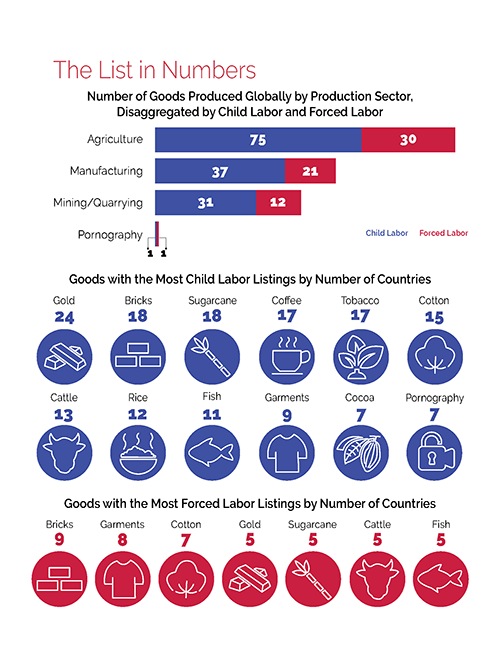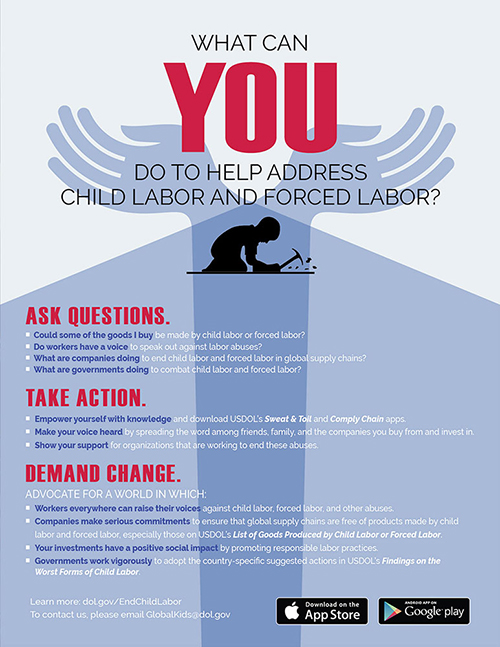List of Goods Produced by Child Labor or Forced Labor
The Bureau of International Labor Affairs (ILAB) maintains a list of goods and their source countries which it has reason to believe are produced by child labor or forced labor in violation of international standards, as required under the Trafficking Victims Protection Reauthorization Act (TVPRA) of 2005 and subsequent reauthorizations. The List of Goods Produced by Child Labor or Forced Labor comprises 159 goods from 78 countries and areas, as of September 28, 2022.
ILAB maintains the List primarily to raise public awareness about forced labor and child labor around the world and to promote efforts to combat them; it is not intended to be punitive, but rather to serve as a catalyst for more strategic and focused coordination and collaboration among those working to address these problems.
Publication of the List has resulted in new opportunities for ILAB to engage with foreign governments to combat forced labor and child labor. It is also a valuable resource for researchers, advocacy organizations and companies wishing to carry out risk assessments and engage in due diligence on labor rights in their supply chains.
The countries on the List span every region of the world. The most common agricultural goods listed are sugarcane, cotton, coffee, tobacco, cattle, rice, and fish. In the manufacturing sector, bricks, garments, textiles, footwear, carpets, and fireworks appear most frequently. In mined or quarried goods, gold, coal and diamonds are most common.
ILAB published the initial TVPRA List in 2009 and updated it annually through 2014, following a set of procedural guidelines that were the product of an intensive public consultation process. ILAB now updates and publishes the List every other year, pursuant to changes in the law.
Procedural Guidelines
On January 25, 2024, ILAB's Office of Child Labor, Forced Labor, and Human Trafficking published Procedural Guidelines for the development and maintenance of the List of Goods from countries produced by child labor or forced labor in violation of international standards.
| Country/Area Sort ascending | Good | Exploitation Type |
|---|---|---|
| Paraguay | There is evidence that children ages 5 to 17 grow melons in Paraguay. In 2016, the Government of Paraguay published representative results from the Survey of Activities of Rural Area Children and Adolescents 2015. The survey considers a working child to be engaged in child labor if the child is below the minimum age for employment of 14 or the child is performing work that is hazardous according to national legislation. The survey estimates that 301,827 children ages 5 to 17 perform hazardous work in rural areas of Paraguay and indicates that children working in agriculture experience accidents and illnesses, including from using dangerous tools and handling chemicals. According to the survey, almost 13 percent of Paraguayan children engaged in child labor in agriculture do not attend school. The survey estimates that 8,879 child laborers grow watermelons and 5,292 child laborers grow melons throughout rural areas in Paraguay. Approximately 4,879 child laborers growing watermelons are under the minimum age for employment in Paraguay. The survey indicates that more boys are engaged in child labor producing watermelons and melons than girls. The release of this survey demonstrates the Government of Paraguay’s commitment to addressing child labor and its acknowledgement that data collection is vital to the design and implementation of sound policies and programs. |
Child Labor |
| Paraguay | There is evidence that children ages 5 to 17 raise cattle in Paraguay. National legislation designates cattle raising as a hazardous activity prohibited for children in Paraguay. In 2016, the Government of Paraguay published representative results from the Survey of Activities of Rural Area Children and Adolescents 2015. The survey considers a working child to be engaged in child labor if the child is below the minimum age for employment of 14 or the child is performing work that is hazardous according to national legislation. The survey estimates that 301,827 children ages 5 to 17 perform hazardous work in rural areas of Paraguay and indicates that children working in agriculture experience accidents and illnesses, including from using dangerous tools and handling chemicals. According to the survey, almost 13 percent of Paraguayan children engaged in child labor in agriculture do not attend school. The survey estimates that 142,127 child laborers raise cattle throughout rural areas in Paraguay. Approximately 67,141 child laborers raising cattle are below the minimum age for employment in Paraguay. The survey indicates that more boys than girls are engaged in child labor in cattle raising. The release of this survey demonstrates the Government of Paraguay’s commitment to addressing child labor and its acknowledgement that data collection is vital to the design and implementation of sound policies and programs. |
Child Labor, Forced Labor |
| Paraguay | There is evidence that children ages 5 to 17 grow tomatoes in Paraguay. In 2016, the Government of Paraguay published representative results from the Survey of Activities of Rural Area Children and Adolescents 2015. The survey considers a working child to be engaged in child labor if the child is below the minimum age for employment of 14 or the child is performing work that is hazardous according to national legislation. The survey estimates that 301,827 children ages 5 to 17 perform hazardous work in rural areas of Paraguay and indicates that children working in agriculture experience accidents and illnesses, including from using dangerous tools and handling chemicals. According to the survey, almost 13 percent of Paraguayan children engaged in child labor in agriculture do not attend school. The survey estimates that 13,095 child laborers grow tomatoes throughout rural areas in Paraguay. Approximately 6,363 child laborers growing tomatoes are below the minimum age for employment in Paraguay. The survey indicates that more boys than girls are engaged in child labor producing tomatoes. The release of this survey demonstrates the Government of Paraguay’s commitment to addressing child labor and its acknowledgement that data collection is vital to the design and implementation of sound policies and programs. |
Child Labor |
| Paraguay | Child Labor | |
| Paraguay | There is evidence that children ages 5 to 17 raise hogs in Paraguay. In 2016, the Government of Paraguay published representative results from the Survey of Activities of Rural Area Children and Adolescents 2015. The survey considers a working child to be engaged in child labor if the child is below the minimum age for employment of 14 or the child is performing work that is hazardous according to national legislation. The survey estimates that 301,827 children ages 5 to 17 perform hazardous work in rural areas of Paraguay and indicates that children working in agriculture experience accidents and illnesses, including from using dangerous tools and handling chemicals. According to the survey, almost 13 percent of Paraguayan children engaged in child labor in agriculture do not attend school. The survey estimates that 199,333 child laborers raise hogs throughout Paraguay. Approximately 120,414 child laborers raising hogs are below the minimum age for employment in Paraguay. The survey indicates that more boys than girls are engaged in child labor in hog raising. The release of this survey demonstrates the Government of Paraguay’s commitment to addressing child labor and its acknowledgement that data collection is vital to the design and implementation of sound policies and programs. |
Child Labor |
| Paraguay | Child Labor | |
| Panama | Child Labor | |
| Panama | Child Labor | |
| Pakistan | Child Labor | |
| Pakistan | There are reports that children as young as age five are forced to work in the production of carpets, often through a system of bonded labor. Based on reports from the ILO and the Organization for Economic Co-Operation and Development (OECD), as many as half a million children have been producing carpets under conditions of forced labor throughout the country. Children of migrants, refugees, and impoverished families are particularly vulnerable to this practice. Typical of the Pakistani “peshgis” system, children are often sent to work to pay off their family's debt. Families accept a loan in the form of advanced payment for a year of their child's work, and the child is prohibited from leaving the workplace until the debt is paid in full. The children live in the workplace, away from their families, and do not have the freedom to leave. Some children are forced to work without equipment to protect them from exposure to toxic chemicals and dust. The children are paid little, and deductions are taken from their wages for food and shelter. Some children are fined or beaten for any mistakes. |
Child Labor, Forced Labor |
your hand? Download ILAB's Sweat & Toil App today!
Are you a company looking to fight child labor and forced labor in supply
chains?





